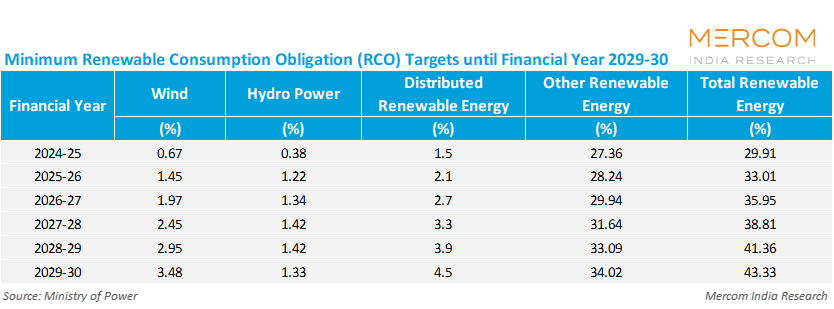Government Issues RCO Compliance Regime for Designated Consumers
The renewable consumption obligation can also be met by power stored from energy storage systems
September 30, 2025
Follow Mercom India on WhatsApp for exclusive updates on clean energy news and insights
The Ministry of Power (MoP) has prescribed a renewable energy consumption obligation (RCO) for designated consumers to achieve a 43.33% target by the financial year 2030.
The regulation specifies a minimum share of renewable energy consumption for electricity distribution licensees, open access consumers, and captive users.
The target of 43.33% RCO by FY 2030 comprises 3.48% from wind energy, 1.33% from hydro energy, 4.5% from distributed renewable energy (DRE), and 34.02% from other renewable energy sources.
The RCO has been specified as follows:
For hilly and North-Eastern states and union territories, including Arunachal Pradesh, Assam, Manipur, Meghalaya, Mizoram, Nagaland, Sikkim, Tripura, Himachal Pradesh, Uttarakhand, Jammu and Kashmir, and Ladakh, the distributed renewable energy (DRE) obligation will be at 50% of the specified RCO levels.
For distribution licensees catering exclusively to urban consumers, the DRE obligation will be 75% of the specified RCO level.
The balance share of the DRE component for these states and union territories will be adjusted under the “other renewable energy” component obligation.
The wind energy obligation must be met through power generated from wind projects commissioned after March 31, 2024.
Similarly, the hydro energy obligation must be met through power generated from hydro projects commissioned after March 31, 2024. The RCO obligation requirement can also be met through the free power allotted to states or distribution licensees from such projects.
In addition, the RCO obligation can be met from hydro power projects located outside India on a case-by-case basis.
The DRE obligation must be met from renewable energy projects with a capacity of up to 10 MW. These projects can include solar installations of all configurations, such as net metering, gross metering, virtual net metering, group net metering, and behind-the-meter systems, as well as any other renewable energy sources notified by the Central Government.
The RCO obligation under the other renewable energy component can be met from renewable energy projects other than wind and hydro projects commissioned after March 31, 2024. It must also not include projects included under the DRE obligation component.
The hydro power projects included under the other renewable energy obligation component must be commissioned before April 1, 2024. It can also include projects co-firing biomass pellets and charcoals produced from municipal solid waste.
The shortfalls in RCO under wind, hydro, and other renewable energy can also be met through surpluses from other obligation components.
Surpluses from other RCO components cannot meet the DRE component’s requirements; however, surpluses from DRE can be used to offset the shortfall in other RCO components.
Open Access Consumers
Open access consumers and captive users identified as designated consumers can meet their total RCO from any renewable energy source.
For open access consumers, the obligation will include power consumption at the point of drawal from the grid.
For captive users, the RCO will apply to electricity generated and self-consumed, excluding auxiliary consumption. The RCO will exclude 50% of the electricity generated and self-consumed from fossil fuel-based cogeneration power projects, as well as 50% of the fossil fuel-based electricity consumed in aluminum smelters.
The RCO can also be fulfilled by consuming power through an energy storage system.
Alternatively, RCO can also be met by purchasing or through self-generated renewable energy certificates (RECs) issued under the Central Electricity Regulatory Commission’s (CERC) regulations.
It can also be met by RECs acquired through Virtual Power Purchase Agreements.
The RCO can be met by paying the buyout price determined by the CERC.
The payment received through the buyout mechanism must be credited to the Central Energy Conservation Fund, and 75% of the fund must be transferred to the state energy conservation fund.
The fund will support the development of specified renewable energy sources and storage capacities.
Compliance with the RCO under the DRE obligation will be measured in kilowatt-hours (kWh) units. If generation data is unavailable, the reported capacity will be converted into energy generation using a multiplier of 4 kWh per kilowatt per day.
Distribution Licensees
For distribution licensees classified as designated consumers, the RCO will be calculated based on the total electricity supplied to consumers within the distribution licensee’s service area.
The calculation will exclude power consumed by open access users sourcing electricity from outside the distribution licensee, as well as electricity generated and captive consumption of power.
The RCO compliance for multiple designated consumers under common control will be considered on an aggregate basis, at the holding company level as defined in the Companies Act, 2013, or at the level of a cooperative society registered under the relevant Co-operative Societies Act.
Designated consumers must submit their certified energy accounts for the year 2024–2025 by October 31, 2025, and by July 31 for each subsequent year.
Any shortfalls in meeting the RCO after the purchase of RECs or payment of the buyout price must be reported in a compliance report by March 31, 2026, for the 2024–2025 year, and by December 31 for the following year.
In March 2025, MoP proposed amendments to refine the regulatory framework governing renewable energy consumption by designated consumers, including electricity distribution licensees, open access consumers, and captive users. The Bureau of Energy Efficiency will oversee the compliance and submit periodic reports to the government.
Subscribe to Mercom’s real-time Regulatory Updates to ensure you don’t miss any critical updates from the renewable industry.
